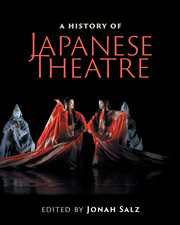Book contents
- Frontmatter
- Contents
- List of figures
- List of tables
- Contributors
- Contributors’ biographies
- Foreword
- Acknowledgments
- Note on Japanese terms
- List of abbreviations
- Timeline
- Editor's introduction
- I Traditional theatres
- Preface to Part I Japanese civilization arises
- II Modern theatres
- Preface to Part II
- III Arcs and patterns
- IV Theatre architecture
- Preface to Part IV Evolution of Japanese theatre architecture
- 16 Premodern patterns of spectatorship and space
- 17 Modernization of theatrical space, 1868–1940
- 18 Postwar theatres: development and diversifi cation
- Interlude National theatres and funding
- V Theatre criticism
- VI Intercultural influences
- Epilogue: Frozen words and mythology
- Further reading
- Index
16 - Premodern patterns of spectatorship and space
from Preface to Part IV Evolution of Japanese theatre architecture
Published online by Cambridge University Press: 05 July 2016
- Frontmatter
- Contents
- List of figures
- List of tables
- Contributors
- Contributors’ biographies
- Foreword
- Acknowledgments
- Note on Japanese terms
- List of abbreviations
- Timeline
- Editor's introduction
- I Traditional theatres
- Preface to Part I Japanese civilization arises
- II Modern theatres
- Preface to Part II
- III Arcs and patterns
- IV Theatre architecture
- Preface to Part IV Evolution of Japanese theatre architecture
- 16 Premodern patterns of spectatorship and space
- 17 Modernization of theatrical space, 1868–1940
- 18 Postwar theatres: development and diversifi cation
- Interlude National theatres and funding
- V Theatre criticism
- VI Intercultural influences
- Epilogue: Frozen words and mythology
- Further reading
- Index
Summary
Although traditional Japanese theatre genres (bugaku, kagura, noh-kyogen, kabuki, bunraku) have their own unique stages, certain commonalities are here discussed concerning the particular interactive relationship of actor and audience.
Fluctuating frontality, mutual frontality, and a lateral perspective
A useful reference for understanding theatrical performance historically is the late twelfth-century work Nenchū gyōji emaki (Annual events scroll). Three different types of cockfight are portrayed: that of commoners, one in the garden of a wealthy family, and another at the imperial court. The commoners' cockfight, held in the grounds of a shrine, depicts commoners encircling the cocks. This ring can be divided into two groups facing each other. The cockfight held in a wealthy family's garden portrays the higher-class spectators gazing from the balcony of a mansion, bisecting the axis of vision drawn by two groups of commoners observing from the side. In the cockfight held in the imperial court, tents have been placed where the commoners were, thereby preventing that spectatorial perspective, with only the axis of the nobles’ gaze remaining. Thus the performance “front” fluctuates according to participants’ gaze.
In the same scroll, the scene in which a miko (Shinto priestess) dedicates a performance of kagura (sacred Shinto music and dance) to the gods in order to heal illness at the Imamiya festivals is particularly significant. The main audience for the event is the gods, while the hosts are the human Shinto priests. The dance centers on gods and humans facing each other directly: in other words, a “double frontality” as host and guest face each other. Also noteworthy is the gaze of the audience viewing the performance from the small hut to the left of the shrine, which bisects the gazes of gods and priests. In this ritual environment, the “side” is the closest and most effective place from which to observe without obstructing. Spatially, for uninvited onlookers gazing through gaps between trees, the side would probably be the best place. Thus, a lateral view becomes an extremely effective perspective according to the structure of medieval performance spaces. In fact, this side-view appears frequently in Japanese performing art spaces, such as the waki-za side area of noh theatres, or seats straddling the hanamichi walkway in kabuki (see Figure 15).
- Type
- Chapter
- Information
- A History of Japanese Theatre , pp. 419 - 422Publisher: Cambridge University PressPrint publication year: 2016



